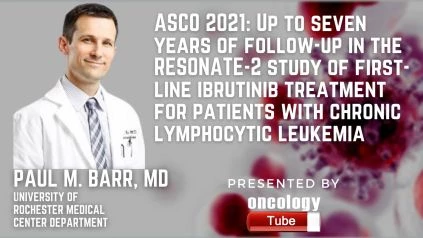Paul M. Barr, MD from the University of Rochester Medical Center Department of Neurobiology and Anatomy speaks about the ASCO 2021 Abstract – Up to seven years of follow-up in the RESONATE-2 study of first-line ibrutinib treatment for patients with chronic lymphocytic leukemia.
Link to Abstract:
https://meetings.asco.org/abstracts-presentations/198840
Background information:
Ibrutinib, a once-daily Bruton’s tyrosine kinase inhibitor, is the only targeted therapy that has shown to improve progression-free survival (PFS) and overall survival (OS) in patients with previously untreated chronic lymphocytic leukemia/small lymphocytic lymphoma (CLL/SLL) in multiple randomized phase 3 studies. The RESONATE-2 trial of first-line ibrutinib vs. chlorambucil in older patients with CLL/SLL has released long-term follow-up results.
Methodologies:
In the RESONATE-2 phase 3 trial, older patients (65 years [y]) with previously untreated CLL/SLL and no del(17p) (N=269) were randomly assigned 1:1 to once-daily single-agent ibrutinib 420 mg until disease progression (PD) or unacceptable toxicity (n=136) or chlorambucil 0.5–0.8 mg/kg up to 12 cycles (n=133). PFS, OS, ORR, and safety were all considered as outcomes. Long-term responses were evaluated by an investigator using the 2008 iwCLL criteria.
The following are the outcomes:
Significant PFS advantage was preserved for pts treated with ibrutinib versus chlorambucil after up to 7 years of follow-up (median, 74.9 months; range, 0.1–86.8) (hazard ratio [HR] 0.160 [95 percent confidence interval (CI): 0.111–0.230). PFS was 61 percent in patients treated with ibrutinib at 6.5 years, compared to 9 percent in those treated with chlorambucil. Ibrutinib-treated pts with high-risk genomic characteristics of unmutated IGHV (HR 0.109 [95 percent CI: 0.063–0.189]) or del(11q) (HR 0.033 [95 percent CI: 0.010–0.107]) showed a PFS improvement across all categories. With ibrutinib therapy, the overall survival rate was 78 percent after 6.5 years. The ORR for ibrutinib-treated patients was 92 percent, with the complete response (CR/CRi) rate improving to 34 percent with this follow-up. For hypertension (5–6y interval: 5%, n=4; 6–7y: 4%, n=3) and atrial fibrillation (5–6y: 1%, n=1; 6–7y: 1%, n=1), ongoing rates of grade 3 adverse events (AEs) of interest were low; no grade 3 significant hemorrhage occurred in 5–7y. During the 5–6y and 6–7y periods, 1% (n=1) of pts had dose reductions due to grade 3 AEs. During full follow-up, 31 patients had dosage reductions owing to any-grade AEs, with 22/31 (71%) of those seeing resolution or improvement. The most common reason for 5–7y discontinuations was PD (5–6y: 5%, n=4; 6–7y: 6%, n=4). Any-grade AEs resulting to cessation were found in 3% (n=2) of pts aged 5–6 years, but none in those aged 6–7 years. With more than 7 years of follow-up, 47% of patients are still on single-agent ibrutinib.
Final Thoughts:
Long-term findings from RESONATE-2 show that first-line ibrutinib therapy improves PFS and OS in patients with CLL, even those with high-risk genetic characteristics. Over time, people’s reactions become more complex. At up to 7 years of follow-up, rates of grade 3 AEs of interest remained low, and subsequent discontinuations and dosage reductions owing to AEs were uncommon; most AEs resulting to dosage reduction resolved or improved. Ibrutinib is still well tolerated, with no new safety concerns.
NCT01722487, NCT01724346

